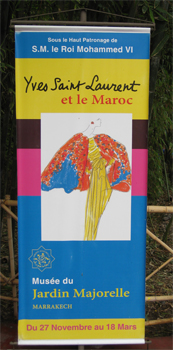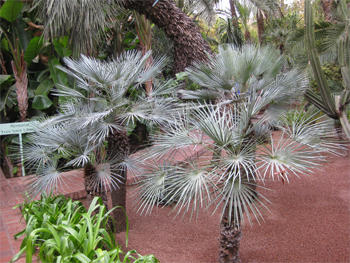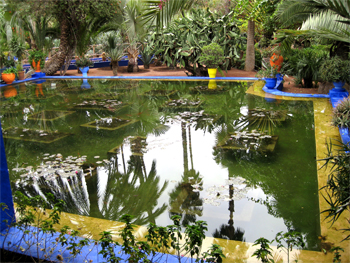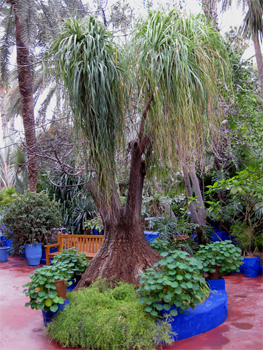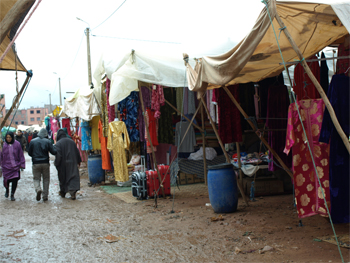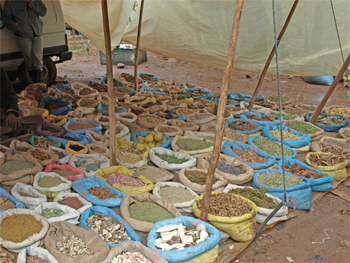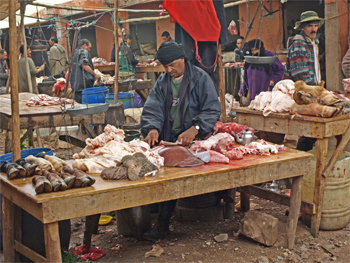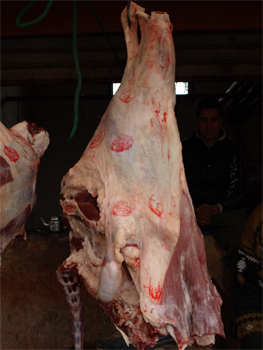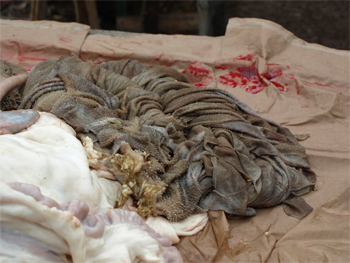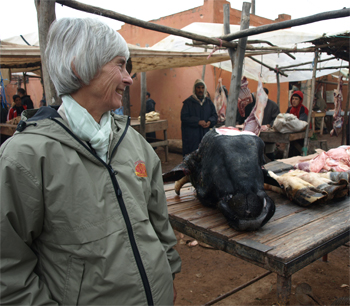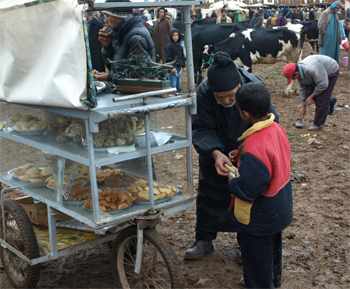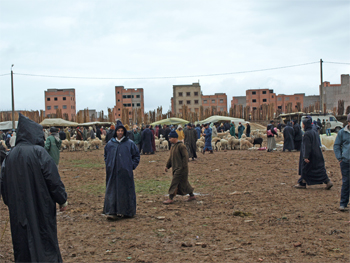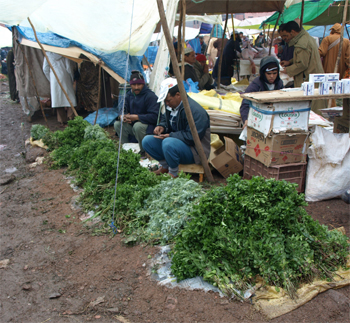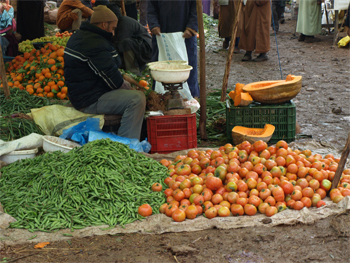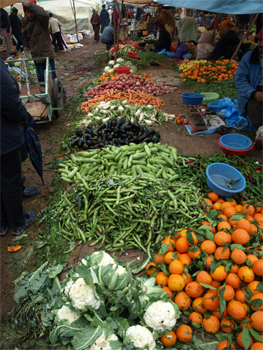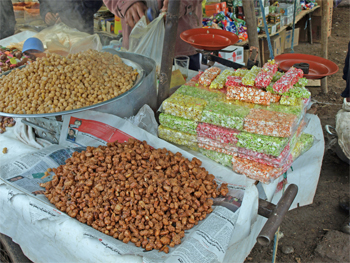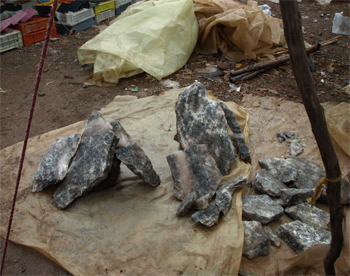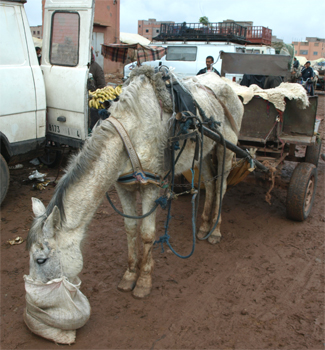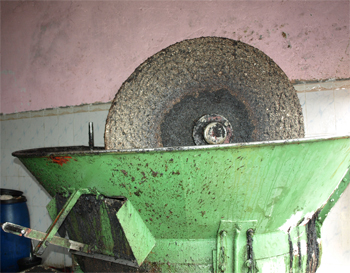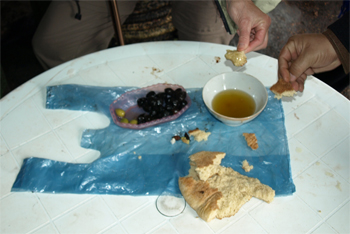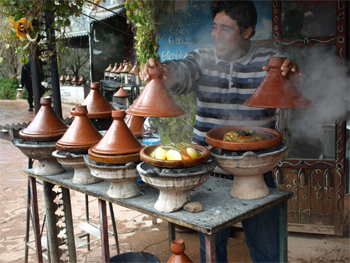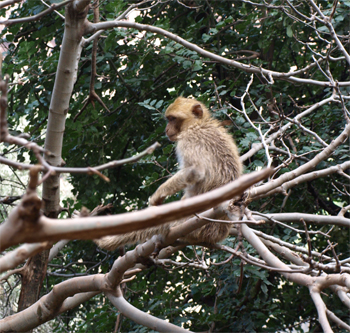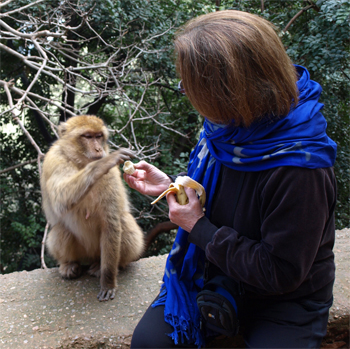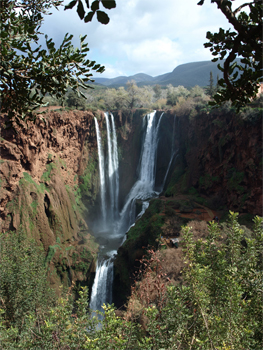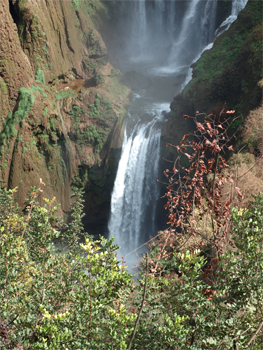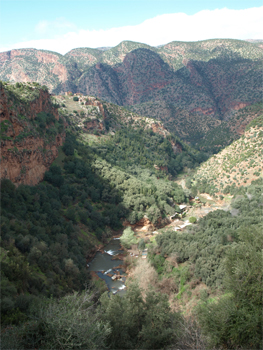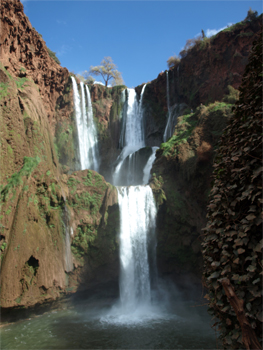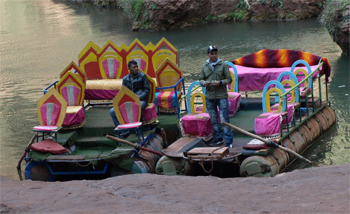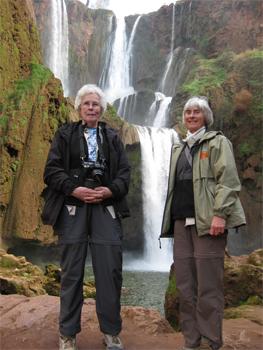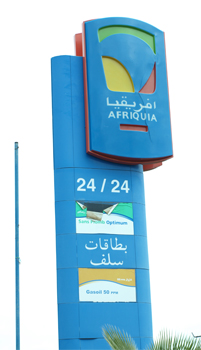Wed., 2/16/11 - Mohamed Ali's Birthday and a holiday - Marrakech
This was a day on our own, but we stayed together and Mohamed arranged for a 12 passenger van to take us to the Jardin Majorelle and to a price fixed shopping store. Mohamed went along with us.
The gardens were planted by the son of a French furniture maker, Majorelle. The gardens were opened to the public. When he died, Yves Saint Laurent and his friend, Pierre Berge, bought the mansion and gardens and their foundation keeps them open today. As we walked the paths we decided that the cacti, palms, a wide variety of trees, and flowering bushes were more like a sculpture garden than a flower garden. It was very peaceful and pleasant to walk among. The palace residence was closed but we saw the memorial alcove where Saint Laurent's ashes are buried and walked through the small museum in which a few dozen of his designer dresses were on display (beautiful but no pictures allowed).
Sign advertising Yves Saint Laurent display
|
Jardin Majorelle |
Yves Saint Laurent memorial
|
Jardin Majorelle |
Jardin Majorelle |
Jardin Majorelle - Elephant foot palm
|
The rest of the day we spent shopping, a little, and resting, a lot.
In the evening we had our farewell dinner at a French restaurant (Moroccan would have been better) as all but four of us were departing for Casablanca and home the next day.
Thurs., 2/17/11 - Marrakech - Cascades d'Ouzoud
This morning we said goodbye to our friends and then met Jaafar Aitchtouk, a native of Marrakech, who will be our guide for the next few days on our Marrakech post-tour. We drove north and east from the city toward the High Atlas Mountains and the Cascades d'Ouzoud (the waterfall of the olives). We passed through some of the 60,000 acres of date palm groves here in Marrakech province. The area we drove through was mostly wide, fertile plateaus of agriculture and small Arabic villages.
At the Arab village of Attouia we stopped to visit a weekly market. Animals were for sale and butchers were cutting meat. There were spices and produce and clothes and cooked food. There were even several tents where barbers were trimming hair. The interaction of the people living their normal lives is interesting to observe.
At the Cascades d'Ouzoud we walked out to the upper viewing point and then walked all the way down the stone steps and path to the bottom.
Between the entry to the national forest and the first viewpoint we saw about a dozen Barbary apes (actually macaques). These little fellows are endangered. They were playful and loved Barbara's banana. We were happy to actually see some of these traditional Moroccan creatures.
The falls are spectacular and worth the three hour drive, with stops. The upper falls drop about 36 feet to a pool and rock and then drop another 200 feet in several ribbons. The third drop is about 50 feet. The morning rain showers had stopped and the sun was out for pictures and there were some pretty rainbows.
Cooking lunch |
|
Barbara has found a friend |
Take it nice!
|
Cascades d'Ouzoud - from above
|
Lower cascade |
Cascades d'Ouzoud with rainbow
|
Looking downstream |
Cascades d'Ouzoud - from below
|
Downstream cascade |
Downstream cascades and rapids
|
Waiting for passengers to take up to the falls |
Another "we were there" photo
|
We had another typical Morocco lunch (tagine and fruit) at an outdoor cafe with the falls in the background. The food was good, the "restroom" a challenge.
|
We have stopped at several gas stations along our drives to stretch our legs and use the variety of bathrooms common to Morocco. Half of them are squat toilets and the ones with seats (however, usually the seat is missing) may have toilet paper. For this luxury we pay 1 dirham, about 17 cents. That may buy 4 sheets of TP so we all carry our own. They do clean the stalls. If there is running water to wash our hands, they may provide a community towel for drying - we carry a bandana for that purpose. Some of us are now used to the expected conditions. The gas stations are Ziz, Oilybia, Afriquia, Petram (owned by Esso) and Shell with a few other odd ones. The price of gasoline is nationally set. |
Afriquia gas station
|
Fri., 2/18/11 - Marrakech on our own
Jaafar had no suggestions as to what or where tourists in his home town might like to visit, so using the map Mohamed had given us and the two tour books Teddy and Barbara had, we found our own adventures on this "day of leisure." We walked to the Ensemble Complexe Artisanat and found a nice fixed price cooperative operated by seven groups of handicapped women. There was pottery, fabric, rugs, carved wood, pots and glasses for tea, and leather items to look at and admire without any hustling. We browsed through a variety of artisan’s shops and watched many of the owners working at their crafts. We always enjoy seeing how things are made.
Next we walked to the ritzy Hotel La Mamounia, hoping to get a look inside this hotel and casino that costs $1200 to $12,000 US a night with a week minimum stay. The entry guards said there was a dress code and would not admit us. We were all dressed nicely, not in jeans and T-shirts like a couple who were staying there and entered while we were standing there. Oh well, a cup of coffee in the cafe probably cost a ridiculous amount anyway.
Marge and I returned to the hotel while Barbara and Teddy headed back to the souks.
At 6 PM the four of us walked up to Jemaa Square and wandered among the masses of people out enjoying the carnival atmosphere in the square on this balmy full moon evening. We saw the storytellers, the "medicine" man, men heating water on braziers and selling mint tea, a falcon that a charmer was trying to get to do something, and the male "belly dancer" impersonators. The funniest might be the watermen who wear odd outfits and hats, have tin cups attached to their dress, and carry a goatskin of water with a spigot at one end. In the old days you could drink the water they poured into one of their cups.
We walked through the two isles of food tents and choose the one to sit at and have dinner. We asked for couscous and kabobs and were served: tomato (unpeeled so we didn't eat them), fried eggplant with tomato and green pepper, couscous with zucchini, carrot and turnips, and chicken, onion, green pepper and tomato kabobs. Teddy had seafood. It was very good for only $15. We soaked up the atmosphere and then walked the mile back to our hotel.
